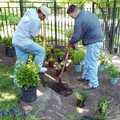 美國堪薩斯市都會區的居民自2005年中期以來,已建造了86座雨花園,打造雨花園的計劃並持續進行中,預期數量將達一萬座,希望藉此降低廢水排放量以防止水道污染惡化。一萬座雨花園的行動並非官方計劃,而是由政府與民間共同倡議,包括市民、公司企業、教育界、非營利組織及政府機關等,其中包括堪薩斯市都會區水利署。
美國堪薩斯市都會區的居民自2005年中期以來,已建造了86座雨花園,打造雨花園的計劃並持續進行中,預期數量將達一萬座,希望藉此降低廢水排放量以防止水道污染惡化。一萬座雨花園的行動並非官方計劃,而是由政府與民間共同倡議,包括市民、公司企業、教育界、非營利組織及政府機關等,其中包括堪薩斯市都會區水利署。
雖說這10,000座雨花園的行動方案,但還是吸引了民選官員的支持。堪薩斯市長巴恩斯(Kay Barnes)表示:「要保護我們的溪流免受污染、讓我們的家園和產業免於水患,需要一套考量全區域、從上游到下游都完全發揮效用的方式。」
每座雨花園就像是一個淺盆、或是一個碗,當中種滿了怡人的原生種植物,以發揮保水及過濾雨水的功能。其原理是,利用植物需求水分的特性,其根部會深入堪薩斯市地區的黏土層,藉此牢牢地將雨水逕流留在土壤中。
在某種程度上,10,000座雨花園可說是一項公共教育行動,而且正顯現出功效。
2003年間,美國中部地區委員會(MARC)針對了堪薩斯都會區居民推動史上頭一次的水質意識民意調查。這項調查是搭配另一項更龐大的計畫,即評估水質教育對大眾整體的認知和行為發揮什麼樣的影響。在該次首度調查中,只有不到一半的受訪者認為他們能採取一些行動來幫助改善水質,另只有25%的受訪者看過或聽過有關水質的宣導廣告。
該次民調之後的六週內,一萬座雨花園的行動在電視、廣播與出版品上大幅宣導,結果顯示,大眾對於雨水議題的公共意識比六個月前上升了30%。
2005年期間,MARC在堪薩斯都會區進行了第二次居民水質認知調查。這次民調顯示有超過半數的公民(53%)看過或聽聞過相關資訊。
參與一萬座雨花園的幕後無名大眾,對他們來說,解決辦法是顯而易見的。一萬座雨花園行動的網站上寫著以下的訊息:「綠色的解決方案,能有效降低溪流裡的污染物,而且其效果是遞增的。」「原生植物不但耐旱、不需施肥、支持野生動物生存,而且美觀,它們的深根還能讓水質透果土壤過濾,而不是直接流入排水系統。」
Since mid-2005, Kansas City metropolitan area residents have built 86 rain gardens and counting - counting up to 10,000 - the number of rain gardens they want to build to reduce the amount of runoff that pollutes their waterways. 10,000 Rain Gardens is not a government program but a public-private initiative, involving citizens, corporations, educators, nonprofit organizations and government agencies such as the Kansas City Metropolitan Area Water Services Department.
Even though it is not a government program, the 10,000 Rain Gardens initiative has attracted the support of elected officials.
"Protecting our streams and rivers from pollution and our homes and businesses from flooding requires a regional approach to be truly effective upstream and downstream," said Kansas City Mayor Kay Barnes.
A rain garden is a shallow basin filled with native plants that hold and filters rain. Stormwater runoff is captured in a small bowl-like garden that is planted and maintained with attractive, thirsty native plants whose roots grow deep into clay soils common to the Kansas City area.
In part, 10,000 Rain Gardens is a public education initiative, and it appears to be working.
In 2003 the Mid-America Regional Council (MARC) conducted a first, benchmark water quality survey of residents in the metropolitan Kansas City area.
The survey is part of an ongoing effort to measure the impact that water quality education efforts in the region are having on the public's overall awareness and behavior.
In that first survey, less than half those questioned thought they could do something to help improve water quality. Only 25 percent of those surveyed had seen or heard ads related to water quality.
After a recent six week publicity campaign for 10,000 Rain Gardens in television, radio and print, public awareness of stormwater issues is up 30 percent from six months before.
During 2005, MARC conducted its second water quality survey of residents in the metropolitan Kansas City area. This poll showed a majority of citizens, 53 percent, said yes, they have seen or heard information.
To the people behind 10,000 Rain Gardens the solution is obvious. "Green solutions can have a powerful cumulative effect in reducing pollutants in our rivers and streams," 10,000 Rain Gardens says on its website. "Native plants are drought-tolerant, require no fertilizer, support wildlife, look great, and their deep roots help water to infiltrate into the soil instead of into the stormwater system."






